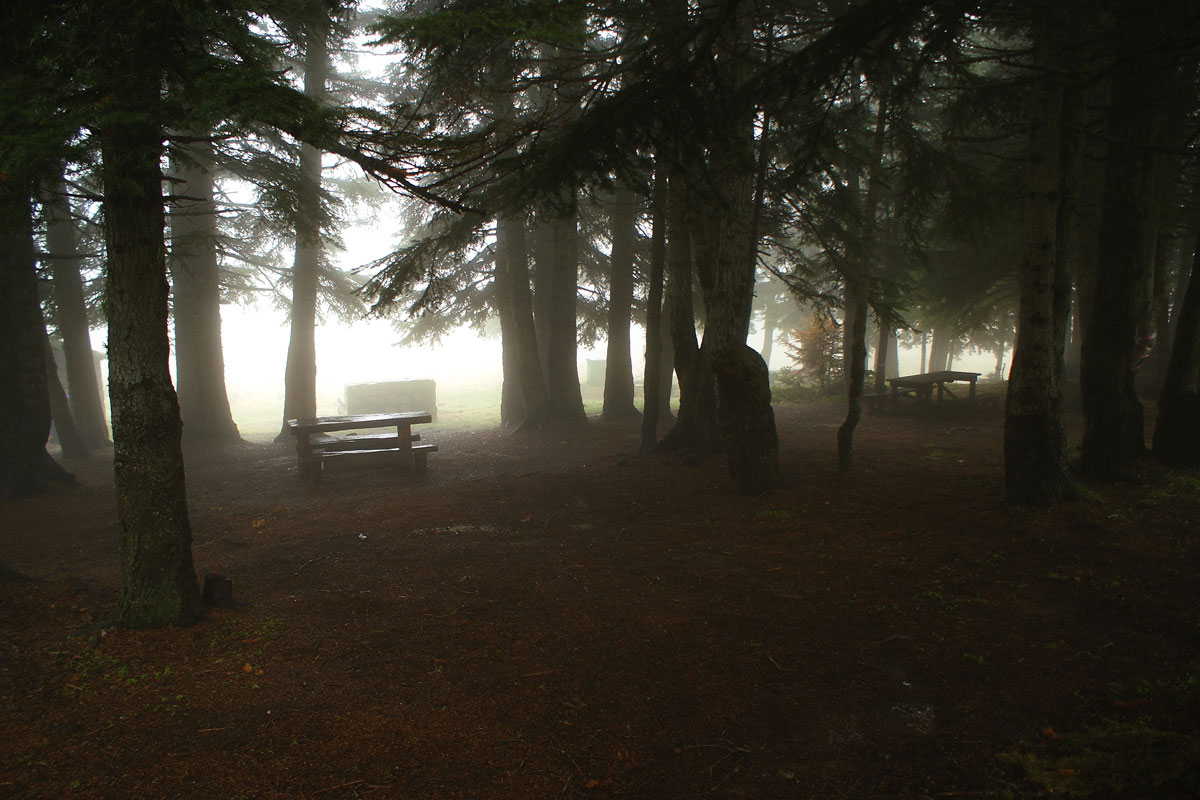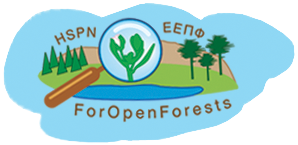Main menu
Conservation of priority forests and forest openings in "Ethnikos Drymos Oitis" and "Oros Kallidromo" of Sterea Ellada, LIFE11 NAT/GR/1014
Actions
Action C.1: Protection of priority habitats: access control and visitor management

This action includes the implementation of management measures in order to restrict the access of vehicles and control the access on foot to the target habitats. and in order to control the activities of visitors and minimise their impact to the target habitats and species. The detailed specifications for these actions will be provided by action A.8, and their implementation will start on the second year of the project. The proposed locations for the interventions are shown in maps 1 and 2.
The management measures will be implemented by the following subactions:
- Fencing of the areas of the temporary ponds (3170*). Permanent open wooden or metallic pole fences will be established: a) at four ponds on Mt. Oiti (Livadies, Greveno, Louka, North of Trapeza) with a total perimeter of fencing of approximately 300 metres; and b) at three ponds on Mt. Kallidromo (Nevropoli, E of Nevropoli, and Souvala) with a total perimeter of fencing of approximately 1,600 m. The fences will be equipped with lifting barriers in order to allow the entrance of animals as necessary for the implementation of action C.3.
- Establishment of wooden lifting barriers at strategic points, in order to block access roads to vehicles. Five barriers will be established at the access roads to the core area of the National Park of Mt. Oiti which includes all the temporary ponds (3170*) and most of the mountain grasslands (6230*). Five barriers will be established at the access roads to the central area of Mt. Kallidromo which includes all the temporary ponds (3170*) and most of the mountain grasslands (6210*). Certain of the existing roads will be blocked to visitors but retained in order to enable surveillance, maintenance of management measures, fire protection, and any urgent transport.
- Establishment of parking lots at the sites of the road barriers.
- Establishment of signboards with information about the project, the Natura 2000 sites, and the target habitats and species at the locations of the road barriers and parking lots, as well as next to the fenced areas of the temporary ponds (3170*).
- Establishment of wooden information kiosks in appropriate locations at the entrances of the protected areas and within the protected sites. The kiosks will include a wooden pavilion, wooden seats, and a signboard with information on the project and the Natura 2000 sites with indelible text, maps of the area including habitats and paths, and pictures. Four kiosks will be established on Mt. Oiti and 4 more will be established on Mt. Kallidromo.
- Repair and reform of a network of approximately 40 km of existing trails for on-foot visitor traffic on Mt Oti and Mt. Kallidromo. The trails will be cleared, repaired and properly demarcated and signposted. Steps and handrails will be added where necessary. Signboards with information on the project and the Natura 2000 sites will be placed at the beginning and at the end of each trail. The final selection of trails will be made by action A.8. Indicative trails are:
- Mt Oiti: Ypati village-EOS Refuge -Greveno peak and circular path back to EOS Refuge –Trapeza peak.
- Mt. Kallidromo: Anavra village-Panagia church-corssroads to Souvala-Mendenitsa village-Kleisoura ravine-Tithronio village.
- Camping sites will be established at two appropriate locations on Mt. Oiti and two more on Mt. Kallidromo, outside the target habitats, at the periphery of the Natura 2000 sites. The camping sites will be equipped with safe fireplaces, portable lavatories, and running water. Additionally, a signboard with information on the project and the NATURA 2000 sites will be established at each site.
- Two recreation (picnic) sites will be established at appropriate locations on Mt. Kallidromo, outside the target habitats, within the controlled access area. The sites will be equipped with safe fire-places, and wooden benches.
- Fly-tipped waste will be removed from the areas of the temporary ponds (3170*) and mountain grasslands (6210*, 6230*) and deposited at legal waste disposal sites. Removal will be done using light equipment or by hand, as necessary in order to avoid damage of the protected habitats. Waste removal will be implemented once at the first year of the project. Volunteer teams and local NGOs may assist in the removal. The maintenance of the action (surveillance, additional waste removal, waste collection and transportation) after the initial cleaning up will be undertaken by the Municipality of Lamia by own funds.
- Two litter-bins with lid will be established at each parking lot. The existing litter-bins in the area of the habitats will be removed.
We should note the following regarding the long term sustainability of the results of Action C1:
- The main issues regarding sustainability of the results in the long term are maintenance of the infrastructure created (fencing, wooden barriers, information kiosks, camping sites, etc.), and adherence of the stakeholders and the general public to the established guidelines. In order to ensure this, it is necessary to delegate responsibility to the competent authorities in the area.
- The existing Management Body for the National Park of Mt. Oiti is responsible for overall management of GR2440004 and GR2440007, and it will assume responsibility for all necessary actions after LIFE. For GR2440006 no Management Body exists, so the responsibility will be assumed by the RST and the Municipal Authority of Molos-Agios Konstantinos.
- The responsibility for maintenance of the infrastructure will be delegated to the RST Forestry Service, as well as the Municipal Authority of Molos-Agios Konstantinos, and the Municipal Authority of Lamia which supports the proposal. After the submission of our proposal, we have contacted the Municipal Authority of Tithorea, on the western side of Oros Kallidromo, and they have also expressed an interest to support the project, and may be involved in the long-term maintenance. Local NGOs, such as “The Friends of Mount Kallidromo” which supports the proposal, will be involved, mainly through action E4, but also actions E3 and E5, and the Stakeholder Committee, and they can undertake some of the necessary actions (e.g. voluntary removal of waste once a year).
- All necessary after-LIFE actions will be authorized and/or approved by the Management Body and carried out by the RST or Municipal authorities. Funding will come from the State budget, according to the current funding for regional authorities.
This action is necessary in order to protect the target habitats and species from threats related to human activities that take place within the NATURA 2000 sites. Moreover, this action will improve the visitor infrastructure and have a positive socio-economic impact on the local communities.
Fencing and road access control will limit the frequent off-road vehicle traffic, which is a major cause of disturbance and degradation of the target habitats, and will also help in providing a more tranquil environment for the Brown Bear. According to the Management Plan for the National Forest Park of Oiti (LIFE92 NAT/GR/013700), road access control is a necessary measure, while the repair and signposting of trails is a standing request of the local communities. The information signboards will discourage trespassing. Parking lots are necessary in order to avoid uncontrolled trampling of habitats.
Fly-tipping is frequent in the areas of the target habitats and waste is often accumulated. Waste removal and placement of litter-bins at appropriate locations are necessary in order to avoid habitat degradation (e.g. from leaching, resulting in pollution of the mountain grasslands and eutrofication of the ponds) and will also restore the aesthetic value of the sites. The litter-bins established at Nevropolis on Mt. Kallidromo have been placed inappropriately (within the mountain grasslands, by the pond, far from the usual itinerary of the waste collection tracks and they are hard to reach). Currently, picnic and illegal camping activities take place within the mountain grasslands, often immediately next to the temporary ponds. The establishment of camping and picnic sites will prevent habitat degradation (vegetation clearing, trampling, pollution by waste) and increased fire risk caused by these activities. The information kiosks will provide easily accessible information for visitors, encouraging the appropriate and legal behaviour within the protected areas.
- Seven wooden pole fences (total perimeter of approximately 1,900 m) and signboards at the temporary ponds of Mt. Oiti and Mt. Kallidromo.
- 10 wooden lifting barriers, parking lots and information signboards at the locations of access control, on Mt. Oiti and Mt. Kallidromo.
- 20 litter bins at the parking lots.
- 8 information kiosks, on Mt. Oiti and Mt. Kallidromo.
- Four camping sites and two recreation sites, on Mt. Oiti and Mt. Kallidromo.
- Increased accessibility of trails for visitors on-foot.
- Prevention of trampling of the habitats and species by off-road vehicles, and elimination of waste from the target habitats.
- Increase in public awareness.



 news
news









